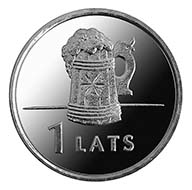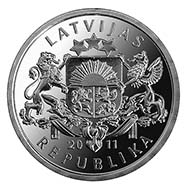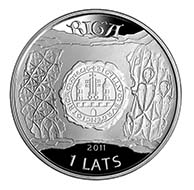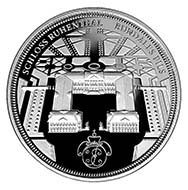June 30, 2011 – 275 years ago the magnificent Rund?le Palace was founded, the Versailles of the Baltics. The Bank of Latvia commemorates this event with a new collector silver coin. Also to the Hansa city Riga a coin is dedicated and a new circulation coin shows a beer mug. Why? Read it here!
A beer mug
As the summer solstice bonfires light up the shortest night of the year, you may hear strains of this Latvian folksong:
“Drink, brother, a mug of beer,
So that rye and barley may grow…”
Latvia – 1 lats – cupro-nickel – 4.80 g – 21.75 mm – Design: Juris Dimiters (graphic design) and Andris Varpa (plaster model) – Mintage limit: 1,000 000 pieces.)
This new coin is made for circulation and dedicated to the beer mug, one of the symbols of the Latvian soltice (Ligo) rituals. The obverse shows the large coat of arms of the Republic of Latvia.
Hansa City Riga
The collector coin is issued within the international coin programme “Hansa Cities” organised by the Finnish Mint Rahapaja Oy. It is dedicated to Riga, one of the eight Hanseatic cities of Latvia, and is the concluding coin in the series.
Latvia – 1 lats 925silver (proof) – 3147 g – 38.61 mm – Design: Gunars Krollis (graphic design), Janis Strupulis (plaster model) – Mintage limit: 15,000 pieces.
On the obverse the 13th century seal featuring Riga City coat of arms is placed in the centre. There are patterns of Gothic ornaments on either side of it. The reverse of the coin is divided into two parts by a water body. The upper part features a panoramic view of the Hanseatic City of Riga. The lower part features the reflections of Hanseatic ships, with the inscription HANZAS PILSETA (Hanseatic city) semicircled below.
The origins of the Hanseatic League date back to the 13th century when the German towns Hamburg and Lübeck concluded an agreement on trading in the Baltic Sea and the North Sea. Uniting dozens of towns in the Baltic and underlying regions, the aim of the Hanseatic League was to protect its members from raids of plunderers, robbers, and pirates as well as to curb the trade expansion of states and cities outside the League.
Riga was a member of the Hanseatic League from 1282 until the final disintegration of the League. Over time, Riga began to evolve as a major port of the Baltic Sea Region. “Riga is a house of hemp and butter.” This is how Riga’s contribution is lauded in a Hansa rhyme. Among the main goods exported from Riga were wax and furs, also flax and hemp.
The Hanseatic League was an attempt to achieve integration in Europe not only in mercantile but also cultural terms, and Riga as a Hansa city was a part of Christian Europe from as early as the 13th century.
Rundale Palace
With the cornerstone of Rund?le Palace laid on 24 May 1736, the idea of European baroque residence arrived in Latvia. Under the Russian court architect Francesco Bartolomeo Rastrelli, a summer palace was built for Count Ernst Johann Biron – the favourite of the Russian Empress Anna Ioanovna – who acceded to the throne of the Duchy of Courland and Semigallia in 1737.
Latvia -1 lats – 925silver (proof) – 31.47 g – 38.61 mm – Design: Guntars Sietins (graphic design), Janis Strupulis (plaster model) – Mintage limit: 5,000 pieces.
The coat of arms of Earl Ernst Johann von Biron taken from the design of the memorial plaque of the Rundale Palace foundation stone is placed in the centre of the obverse of this new collector coin. The reverse features bird’s eye images of the Palace and the adjacent regular park, with semicircled inscriptions SCHLOSS RUHENTHAL on the left and RUNDALES PILS on the right at the top. Beneath the images is the monogram of Ernst Johann, Duke of Courland.
The palace building was under the cover of a roof within a year and a half. The interior was almost finished when the death of Empress Anna Ioanovna in 1740 put an end to Biron’s brilliant career. Ernst Johann Biron became regent of Russia and ruled the vast empire for a total of twenty-two days, after which he was arrested and exiled for twenty-two years. When the Duke returned to Courland, he was soon joined by F. B. Rastrelli, and by 1768 a new interior was complete. Italian painters Francesco Martini and Carlo Zucci as well as the Berlin sculptor Johann Michael Graff created the ornate rococo interior of great artistic value that ranks the Rundale Palace among the most outstanding European palaces.
In 1795, Peter, the last Duke of Courland, abdicated, yet the Rund?le Palace lost none of its glamour as it passed on to the Counts Zubov and Shuvalov. In 1972 when the Rundale Palace Museum was established, renovation of the palace was launched; it is expected to be completed in 2014. The palace has been reborn as an 18th century residence of the Duke with corresponding interiors.
The Rundale Palace is an outstanding monument of Latvian art. The palace along with the park designed by F. B. Rastrelli and the largest rose garden of the Baltic States form a sizeable ensemble surrounded by undisturbed nature of the Zemgale Plain. A European Heritage Site, the Rundale Palace is a very popular tourism destination in Latvia.
For more information on the circulation coins of the Bank of Latvia visit its website.
On these and other collector coins you find further information here.
The splendid Rundale Palace has a very informative site.
If you want to feel like visiting the Versailles of the Baltics personally, look at this film.










